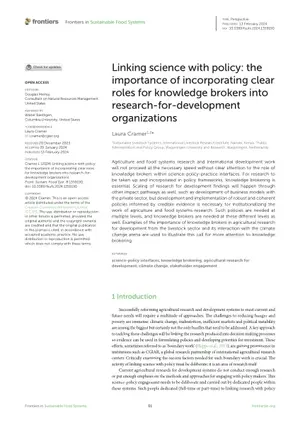
Integrated agriculture and aquaculture (IAA) system, livestock breeds and improved feeding as prioritized innovations for reducing emissions in Kenya’s food systems: Assessing scaling potential using a six-step criteria
Abstract
Agriculture plays a major role in economic growth, but it is also an important source of greenhouse gas emissions in Kenya. To achieve Kenya’s NDC target of cutting GHG emissions by 32% by 2030 relative to business-as-usual (BAU) of 143 MtCO2 eq, there is need to identify and promote scalable innovations for food system emissions reduction. The CGIAR Initiative on Low-Emission Food Systems (Mitigate+) can contribute towards Kenya’s NDC. The Mitigate+ Initiative aims to reduce annual global food system emissions by 7% by 2030. Kenya is among the prioritized countries for the initiative. Consistent with this aim, the scaling work package of the Mitigate+ Initiative developed and applied a prioritization framework to identify two innovations for scaling in Kenya’s food system. The two innovations include (1) a package of improved livestock breeds and improved feeding and (2) Integrated Agriculture and Aquaculture (IAA). As a follow-up prioritization step, a six-step process was implemented to further assess the scalability of the two innovations in Kenya. The framework considers the following steps to transition to a low-emission food system: (1) prioritize technologies and regions; (2) assess the governance models and institutional drivers of emission change; (3) assess the adoption potential of technologies and institutional innovations; (4) develop strategies to overcome the barriers to adoption; (5) design business models to scale technologies; (6) measure climate action and development of co-benefits. This report documents the results of the six-step process as applied to the two innovations prioritized for Kenya. The review of studies across the six steps demonstrates the great scaling potential of both IAA and the package of improved livestock breeds and improved feeds. The prioritized mitigation options provide a good entry point for scaling technologies to reduce emissions in the food system. Creating an enabling environment for the scaling of these innovations is crucial, yet will require focus in addressing the existing gaps, including the availability of data and analysis that estimate the greenhouse gas emission reduction from specific technologies. This gap is particularly wide for the IAA in Kenya.
Citation
Ochenje, I. and Shikuku, K. 2023. Integrated agriculture and aquaculture (IAA) system, livestock breeds and improved feeding as prioritized innovations for reducing emissions in Kenya’s food systems: Assessing scaling potential using a six-step criteria. Nairobi, Kenya: ILRI.







